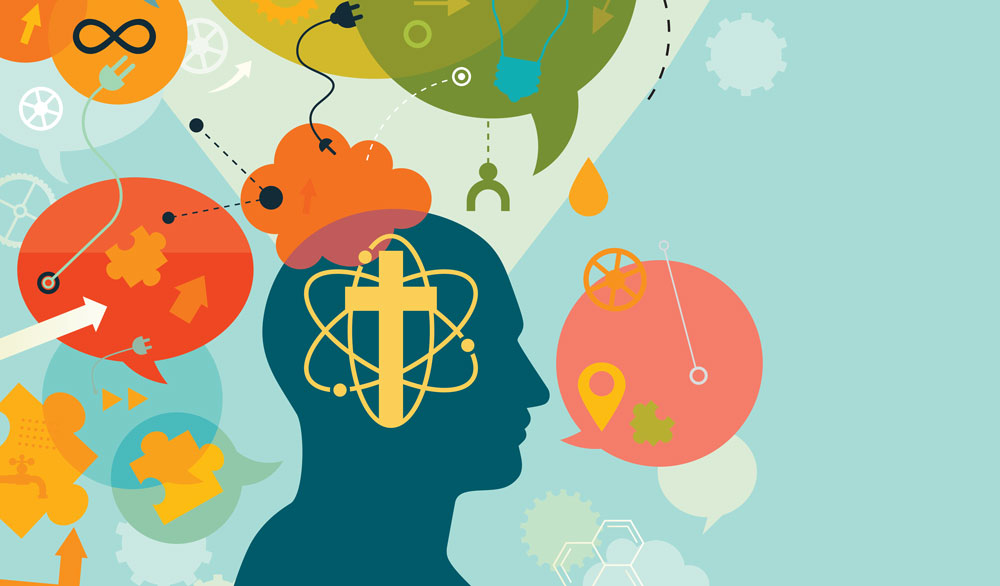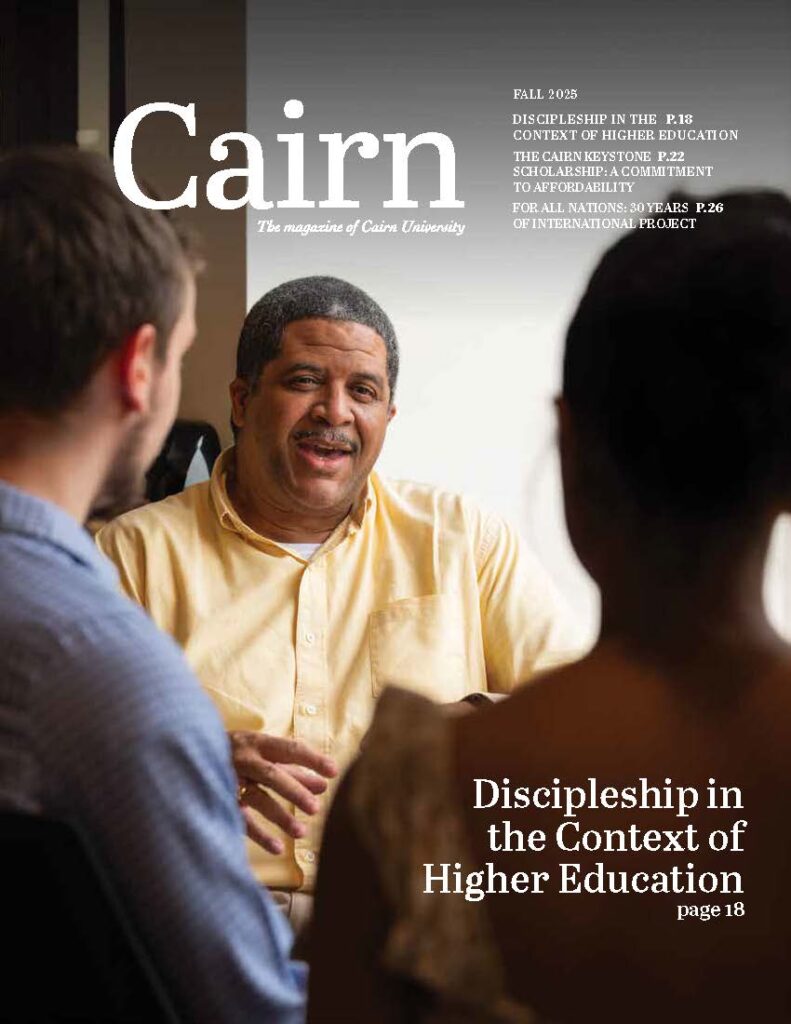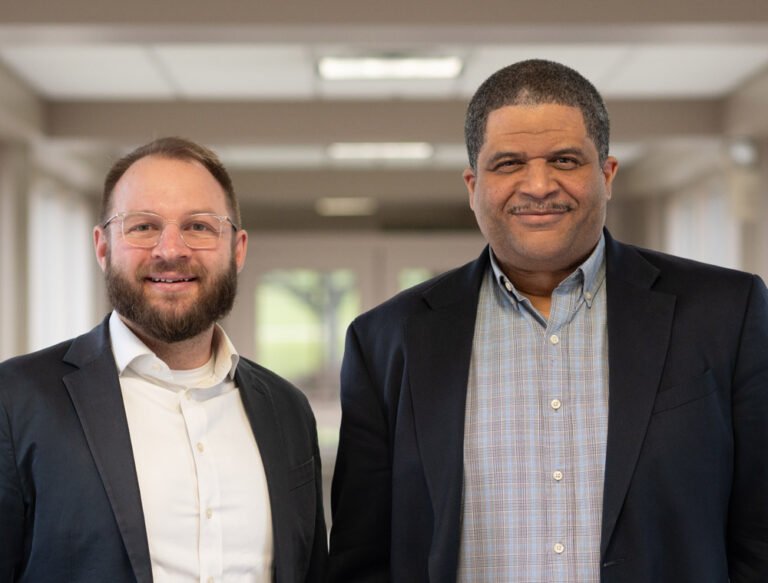When the Lord led me to Cairn University six years ago, it was with the mandate to grow our fledgling science program. Faith and science have long had a largely adversarial relationship. Discussion and debate in the context of “faith or science” or “faith versus science” has dominated. However, it is my deeply held position that when both are correctly interpreted, science and faith will complement and not oppose one another. It behooves all thinking Christians to be well-versed in this relationship, in order to have a voice in the public square on issues like AI, cloning, and sexual identity, among many others.
Science can be defined as the relentless pursuit of answers. Long before the apple fell on Isaac Newton’s head, people pondered and sought answers to the origins and causality of the universe and other phenomena. Indeed, Scripture is replete with such scientific events. The Creation account includes descriptions of time, space, matter, and energy. In Genesis 7:11, “the fountains of the deep” break open during the flood, which seems to be alluding to geological activity. Adam is commanded by God to name the animals, indicating cognitive function and comprehension of language. Further, Adam and Eve became aware of their sin of eating from the tree of the knowledge of good and evil and then hiding their nakedness, evidence of understanding sin, having conscience, and being embarrassed, functions of the limbic system of the brain. The First Law of Thermodynamics, a fundamental and universally accepted scientific concept, states that the total amount of energy in the universe is constant, confirming what was said in Genesis 2:1, that the work of creation was finished. We can see how science, through observation and experimentation, elegantly seeks answers to the “how” questions of the universe. Scientific laws explain physical properties and principles. But science does not, indeed cannot, address the purpose or meaning behind scientific mechanisms. That is where faith comes into the equation and completes our understanding of science.
The human brain is a subject I spent much of my academic life studying. Weighing approximately three pounds, closed off in the dark recesses of our skull, composed mostly of fat and water, and having the consistency of cold oatmeal, it is constantly firing electrical shocks—enough to power a LED bulb—that define our understanding of ourselves, the world around us, and the human experience. One particular function of the brain that has captured my intrigue as both a Christian and a physician is neuroplasticity, which medical science defines as the human brain’s ability to change its structure and function in response to experience of injury. Indeed, the concept of neuroplasticity and the Bible relate in several ways.
The brain can physically and functionally restructure itself through neuroplasticity. This can create new neural networks that represent God’s truth. The psalmist writes in Psalm 139, “For you formed me in my inward parts; you knitted me together in my mother’s womb. I will praise you for I am fearfully and wonderfully made.” Little did David know when he was writing this that he was referring to cadherins, the fine protein mesh that connects our cells, including those in our brain, to each other. We are literally knit together in our mother’s womb! In 2 Timothy 1, Paul writes that “we have not been given a spirit of fear, but of power, love, and a sound mind.” The idea of having a sound mind has the connotation of being able to change your mind, both in structure and function. In other words, the things we think about and the way we think about them and, indeed, ourselves directly cause a structural rerouting of our brain’s neurons and influence human behavior and action. Brain imaging studies at the National Institutes of Health and the University of Pennsylvania have proven this rerouting is not only possible but ongoing. In his book Your Faithful Brain: Designed For So Much More!, Christian psychologist Leonard Matheson writes, “Neuroscience supports the Bible’s integrated and indivisible approach to the human person, including our brain. We’re designed to be completely and fully integrated beings with a soul into which we grow.” This notion lends itself to the spiritual realm as well. Namely, the brain can be transformed through spiritual growth, which can lead to a more Christlike life. When we actively choose to think about God, the church, and society through the perspective of Scripture and when we actively choose to model every aspect of our lives after our Savior, our neural pathways will rewire in such a way as to reflect God’s truth. As our spiritual formation and transformation progresses, this will reinforce the neural pathways that allow us to see God’s truth. In essence, our brain and its neurons play an active role in our sanctification. The opposite is also true: If we choose to focus on those concepts and habits that lead us away from God, our neurons that feed our spiritual self will regress, leading to spiritual dysfunction.
Neuroplasticity can also facilitate cognitive change. That is to say, we can change how we think of ourselves and the world around us. Scripture tells us so in Proverbs 23:7: “As a man thinketh in his heart, so is he” (NKJV). David Stoop, clinical psychologist from Fuller Theological Seminary, writes in his book You Are What You Think, that “It is not what is occurring in our lives that affects our behavior; it is what we believe about what is occurring that matters.” By how we think, and what we think about, humans have the capacity to either feed or starve our souls. Noted neuroscientist Andrew Newburg, writing in his book Neurotheology, writes of studying the brains of nuns when praying: “The scans showed how her brain was able to connect her to the religious and spiritual ideas that she held so dearly.” Jesus tells his disciples in Matthew 10:28 that though they think their lives are in danger, their souls are untouchable. There is a popular phrase that “attitude is everything.” It may not be everything, but to our minds it is influential.
Ultimately, all of this begs the question, “Am I just my brain?” In her book of the same name, author Sharon Dirckx seeks to answer this question. In short, no, humans are not merely the product of their own imaginations or of mutual illusions, as the Hindu philosophers say. But there is a connection between the mind and the body. Indeed, the Bible describes a mind-body connection, which means that what we think affects our physical bodies. Proverbs 4:20–22 tells us that what we think affects our bodies: “My son, pay attention to what I say; turn your ear to my words. Do not let them out of your sight, keep them within your heart; for they are life to those who find them and health to one’s whole body.” 2 Corinthians 4 says that man’s mind is “blinded” until regeneration occurs. Secular scientists would claim that the brain is the mind. This is a view known as reductive physicalism, that the mind is reducible only to its base functions, chemical and physical reactions. An alternate view is that the brain generates the mind, that is, when the working of the brain reaches a high level of complexity, it gives rise to something distinct: the mind. Dirckx calls this non-reductive physicalism. This is the mind that is referred to in 2 Timothy 1, a sound mind that thinks on the things of God and conforms its worldview to God. This is the mind referred to in Romans 12 that is being renewed.
For the Christian, renewing one’s mind is an active process. At every Commencement, the newly minted graduates commit to “cultivating a life of the mind.” As we can see, neuroplasticity is key to our sanctification and growth as believers, and it is an active process. But how does one do all this?
First, study the Bible. Be a constant, conscientious, and dedicated student of the Word. Reading the Bible is the main method for transforming negative thinking into Christlike thoughts. The more time one spends in the Word, the more Christ-oriented one’s neural pathways become. Over time, the more one stays grounded in Scripture, the more they will desire to do so, and what starts out as a conscious, habit-forming activity becomes a mental stimulation to be craved, without which one feels incomplete. This process is known as long-term potentiation, and it is an outgrowth of neuroplasticity.
Prayer is another essential component to Christian neuroplasticity. Prayer enables us to confess our faults and be healed. It is widely understood that prayer changes the structure of the frontal lobe of the brain, which helps one focus our thoughts. Prayer is also thought to reinforce the neural circuits that help with social awareness, empathy, and compassion. Andrew Newberg writes in Neurotheology that just 12 minutes of daily prayer has a “profound impact on our brain. It strengthens a unique neural circuit that specifically enhances our social awareness and empathy and helps us love our neighbor by developing a heightened sense of compassion and subduing negative emotions.”
These spiritual disciplines will affect real change in the wiring of our brains and how we engage with the world. They will compel us to be more mindful: mindful of the thoughts, feelings, and physical condition of ourselves and of others. An article titled “Miracle of the Mind” by Hope College contends that “. . . the principles of neural plasticity, long- term potentiation, and cognitive behavioral therapy are essential for establishing Christlike thoughts in one’s mind.” Continual engagement in God-glorifying behaviors will not only cause one to be salt and light in the world but also reinforce those neural networks. Further, Jeffrey Schwartz, research psychiatrist at Biola University, writes, “When we use spiritual growth to change our brain through self‑directed neuroplasticity, as guided by the Holy Spirit, we are making our own brains more conducive to us being transparent before God, which, through grace, will make us more receptive to God’s plan for us.”
These spiritual disciplines can also lead one to being more compassionate. As one aligns one’s brain to the thoughts of God, we learn to engage the prefrontal cortex of the brain. This is the part of the brain that is concerned with executive function and higher order thinking, which includes thinking outside of oneself and thinking of others. Stimulating the prefrontal cortex can make one be more compassionate and social. It can cause one to seek out human companionship. More than that, it can make one anticipate the needs of others. Through prefrontal action and the release of some hormones, one can also control our behavior in times of stress.
The junction of neuroplasticity and faith offers the believer with an infinitely fascinating lens through which one can view human experiences and our relationship with God. The brain’s remarkable ability to change gives us hope for healing and growth. Whether we recognize it or not, we are renewing our minds, reminding us that we are fearfully and wonderfully made, drawing us closer to our Creator.










